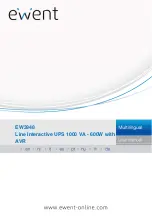
6
Indicator Lights
All Indicator Light descriptions apply when the UPS is plugged into an AC outlet and turned on.
Other UPS Features
Basic Operation
continued
“LINE POWER” LED:
this green LED lights continuously to indicate that the
UPS is ON and supplying your equipment with AC power from a utility
source. The LED flashes to remind you that you have used the ON/OFF
button to place the UPS in “Charge-Only” mode.
“BATTERY POWER” LED:
this yellow LED flashes and an alarm sounds (4
short beeps followed by a pause) to indicate the UPS is operating from its
internal batteries. During a prolonged brownout or blackout, this LED and
the “REPLACE BATTERY” LED will light continuously and an alarm will sound
continuously to indicate the UPS's batteries are nearly out of power; you
should save files and shut down your equipment immediately.
“REPLACE BATTERY” LED:
this red LED lights continuously and an alarm
sounds after a self-test to indicate the UPS batteries need to be recharged
or replaced. Allow the UPS to recharge continuously for 12 hours, and
repeat the self-test. If the LED stays continuously lit, contact Tripp Lite
for service. If your UPS requires battery replacement, visit
www.tripplite.com/support/battery/index.cfm to locate the specific Tripp Lite
replacement battery for your UPS.
“OVERLOAD” LED:
this red LED lights continuously and an alarm sounds
after a self-test to indicate the battery-supported outlets are overloaded. To
clear the overload, unplug some of your equipment from the battery-
supported outlets and run the self-test repeatedly until the LED is no longer
lit and the alarm is no longer sounding.
CAUTION! Any overload that is not corrected by the user immediately
following a self-test may cause the UPS to shut down and cease
supplying output power in the event of a blackout or brownout.
“VOLTAGE CORRECTION” LED (select models only):
Lights green
whenever your UPS is automatically correcting high or low AC line voltage.
The UPS will also click gently. These are normal, automatic operations of
your UPS, and no action is required on your part.
AC Outlets:
the
A
outlets will provide battery backup and surge protection; plug your
computer, monitor and other critical devices here. The
B
outlets will provide surge protection
only; plug your printer and other non-essential devices here. Your UPS is designed to only
support computer equipment. You will overload the UPS if the total VA ratings for all the
equipment you connect to the
A
outlets exceeds the UPS’s Output Capacity (see
Specifications). If you are unsure if you have overloaded the
A
outlets, run a self-test (see
“MUTE/TEST” Button description).
NORM DELAY
OMNIVS1500XL shown
NORM DELAY
OMNIVS1000 shown
NORM DELAY
A
B
B
B
A
A
A
A
A
OMNIVS800 shown
14-04-093-932248.indb 6
4/30/2014 4:47:40 PM







































